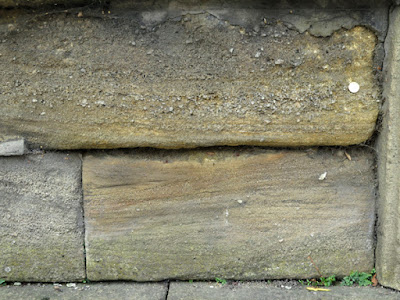In writing this Language of Stone Blog, I have been recording my visits to various places where the geology, landscape and historic stone built architecture are the main attractions – and which reflect the kind of places that I like to visit as a tourist when abroad. To date, although proposed collaborations with colleagues in Spain and Italy - who have similar interests in Geoheritage and tourism - have not yet materialised in practice, my involvement with the Sheffield U3A Geology Group has continued to lay the foundations for these.
During my two trips to Leeds in the latter half of 2018, I identified Leeds Central Library and Leeds Minster as two ‘anchor points’ around which I thought a full day out to explore the ‘Building Stones of Leeds’ could be organised for this group, as I had done in Sheffield earlier in the year. Using The Building Stone Heritage of Leeds as a guide, I finished off my last trip by having another look at some of the buildings on and near to The Headrow, as described in Walk 1.
The massive Town Hall, opened in 1858, was designed as a matter of civic pride to be grander than its neighbouring rivals in the wool trade - Bradford, Halifax and Huddersfield – and uses various local sandstones from the Millstone Grit, including the very coarse variety of the Rough Rock from Bramley Fall that has been used in Kirkstall Abbey and numerous historic buildings in Leeds.
The columns to the south front are built of a much finer grained variety of Millstone Grit – the renowned Darley Dale stone from the Stancliffe Quarry near Matlock in Derbyshire. Although I have not seen any documentary evidence in support, the frieze sculpture and other details here look like they are carved from very similar sandstone.
Flanking the front elevation of the Town Hall, four large Portland stone lions set on vermiculated Rough Rock plinths are well worth looking at in detail. These were added in 1867 but, unlike the similar carved gritstone lions in Saltaire that were installed two years later, they have weathered extremely badly over the years and, in one of the lions, this is emphasised by its advanced decay compared to a nodule of chert, which quite unusually is embedded in the limestone.
Very high levels of atmospheric pollution were once an undesirable by product of the industries in cities and large towns in northern England, with their buildings being attacked by acid rain and encrusted in soot. Although the Carboniferous sandstones used in Leeds – as well as terracotta, faience and brick - have been resistant to the sulphurous pollutants, various limestones used in Leeds have not fared well.
A short distance along The Headrow, the modern extension to Leeds Art Gallery is built out of Crosland Hill sandstone, a medium grained variety of Rough Rock from Huddersfield that contrasts strongly with the stone used in the Town Hall.
Next door at the Henry Moore Institute, the front elevation is clad in an incongruous polished igneous rock from Quebec in Canada – a granodiorite that looks dark green in colour when seen up close, rather than black as seen at a distance.
I ended my day with a quick exploration of Millennium Square, where the Portland limestone Leeds Civic Hall and Leeds City Museum, built out of a very coarse grained Rough Rock from Horsforth, deserve much closer examination.
 |
| Leeds City Museum |





















































